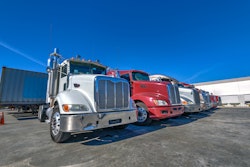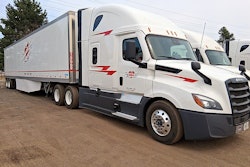Small Business Administration approved 23 percent more loans during the first three months of the current federal fiscal year than in the same period a year earlier, the agency said last month. Legislation enacted in December makes more than $21 billion available to small businesses through the SBA’s two main loan programs.
The Internal Revenue Service has certified the Toyota Prius for model year 2005 as being eligible for the clean-burning fuel deduction. The certification means taxpayers who purchase this vehicle new may claim a tax deduction of $2,000 on Form 1040 for certified vehicles placed in service in 2004 and 2005.
Idaho-based truck owners licensed under the International Fuel Tax Agreement (IFTA) now can renew their IFTA licenses and order decals at no extra charge through the state’s official website.
Alabama’s Legislature recently established a mid-range vehicle weight category, resulting in lower fees for some trucking operations in 2005. A tag for the new P1 category (8,001 to 10,000 pounds) now costs $35 annually, according to the state’s revenue department. Under prior law, trucks with gross weights of 8,000 pounds or less paid $23 for a standard tag; vehicles exceeding that weight but less than 12,001 pounds required a $105 yearly tag.
Hino Trucks and Toyota Financial Services, through Hino dealers, recently offered low-rate/low-payment financing programs for the purchase or lease of medium-duty vehicles.
If 100 percent of something is worth a certain amount, then 10 percent of that same thing is worth one-tenth of that amount, right? Not hardly. This basic calculation may work fine when the item you are analyzing is a commodity. But it doesn’t work at all when it comes to appraising shares of an enterprise, such as your trucking company.
Welcome to the world of valuation discounts, in which the sum of the parts rarely equals the whole. Discounts come into play anytime a business valuation is conducted. Often, businesses undergo valuations annually or when there is a stockholder dispute. In any case, it’s important to understand how valuation discounts work and who benefits from them – and why.
Consider a simple example. Suppose that you are the sole shareholder and that following a business valuation study your trucking company is appraised at $10 million. If you tried to sell a 10 percent stake on the open market, would you get $1 million? No way. The buyer of that 10 percent share would have no rights whatsoever. He couldn’t make the 90 percent shareholder pay him a salary, declare a dividend or even be frugal with the company credit cards. The benefits of holding that 10 percent are dubious absent complete trust and benevolence between the parties.
Your opinion of valuation discounts depends on your point of view. If you’re the minority shareholder looking to sell your stock, you don’t care for them at all. But if you are the majority owner looking to buy back shares or to give them to your kids to head off eventual estate taxes, you absolutely love valuation discounts.
“Valuation discounts vary widely and depend on the particular circumstances of each company,” says Bryan Finison, a certified valuation analyst who frequently is involved in business valuations in the transportation industry. “There is no such thing as a rule of thumb.”
There are two basic types of valuation discounts. The first, which we already have described, is the “minority interest” or “lack of control” discount. If you do not hold 51 percent or more of the stock, you typically cannot outvote the other shareholders, so your minority holdings in the company don’t equal the pro-rata value of those shares. A $1 million pro-rata stake now is really worth, say, $750,000 – with the 25 percent discount applied to compensate the buyer for taking the risk that the major owners might not be very kind to the minority owners.
The second type is called the “lack of marketability” discount, which recognizes the difficulty of selling a business interest in a privately held company. Plus, many companies have restrictions on the sale of the stock, such as giving first right of refusal to other stockholders. What prospective buyer wants to endure the legal and accounting expense and hassle of due diligence, only to have a current shareholder purchase the stake at $1 more than the offer? So slap another 20 percent discount due to lack of marketability on top of the discount for lack of control, and that $1 million pro-rata stake really is worth just $600,000.
If you are selling your stock, of course you will argue for smaller discounts. If you’re buying, you’ll argue for more. Often, the most important circumstance is neither buying nor selling. The Internal Revenue Service considers your business valuation in the context of estate or gift taxes. Given tax rates of almost 50 percent, there’s quite a bit at stake in an IRS audit of a business valuation.
Especially in estate planning, discounts can be magical. Using discounts, you can give away $1,667,000 in assets to a child through a trust or an LLC, maintain complete control and use up only $1 million in lifetime gift tax exemptions. Voila! With the stroke of a pen, more than $300,000 in estate taxes are eliminated instantly, and that much more of the family legacy is kept within the family.
“There’s a lot more than people think that goes into figuring the size of each of the discounts – and all of this is often argued and defended in Tax Court,” Finison says. For example, a company with five really good contracts with routes into excellent areas for return freight likely will receive a smaller discount than a company with no dedicated contracts or lousy routes.
Valuation discounts are complex and confusing, but they can present great opportunities for business owners.
Resourches
“Do you want to know what your business is really worth?” by E. Bryan Finison, courtesy of the Tuscaloosa Business Ink. at this site.
“What can you do to avoid transfer tax audits?” from the Estate Planning Advisor published by Miller Nash LLP, Attorneys at Law, Seattle at this site.
“Overview of Business Valuation Discounts and Premiums and the Bases to Which They are Applied” Chapter 1 of the book “Business Valuation Discounts and Premiums” by Shannon Pratt, published by Wiley & Sons at this site.
Werner reports record earnings
Werner Enterprises reported record revenue and earnings for 2004. Operating revenues of $1.68 billion in 2004 were 15 percent higher than 2003 results. Net income was up 18 percent to $87.3 million.
“A constrained supply of trucks with qualified drivers, combined with a steadily improving economy, are providing truckload carriers with the strongest pricing market in many years,” says Chairman and Chief Executive Officer Clarence Werner. “Considering the significant industry challenge of an extremely difficult driver market, I expect that freight demand and pricing will continue to be favorable in 2005.”
Covenant hit by rise in claims reserve
Covenant Transport reported a 3.6 percent increase in revenue to $603.6 million in 2004, but its net income dropped to $3.4 million following an after-tax charge of $12.2 million in the fourth quarter. The charge relates to an increase in the Chattanooga, Tenn.-based carrier’s estimated liability for casualty and workers’ compensation claims and follows the completion of a previously announced actuarial review of the company’s claims reserves.
“As a result of greater revenue productivity, our operating ratio, excluding the increase to claims reserves, improved 180 basis points,” says David Parker, chairman, president and chief executive officer. “Excluding the increase to claims reserves, our operating ratio – which we define as operating expenses, net of fuel surcharge, as a percentage of freight revenue – was 92.2 percent for the fourth quarter of 2004 compared with 94.0 percent for the fourth quarter of 2003.”
Knight revenue up 30 percent
Phoenix-based Knight Transportation said that its 2004 revenue was up 30.1 percent to $442.3 million and that net income increased 35 percent to $47.9 million.
“We continued to execute our operating model focused on leading growth and profitability,” says Kevin Knight, chairman and chief executive officer. “Our operating ratio improved by more than 180 basis points to 78.9 percent, and our net income was 12.7 percent of revenue, before fuel surcharge, which is the best in our history as a public company. We achieved these results through a combination of expanding our fleet, significant rate increases, greater productivity from our trucks and a never-ending mission of cost-control.”










